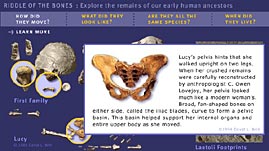In the 6 to 8 million years since the earliest ancestors of humans diverged from the apes, at least a dozen humanlike species, called hominids, have lived on the earth. We know this from the fossilized remains scientists have found in many parts of the world, especially Africa, Asia, and Europe. In addition to proving that these ancient creatures existed, the fossils reveal other important information about when, how, and with what other organisms these animals may have lived.
The structure of the knee and hip joints of the 3-million-year-old species
Australopithecus afarensis, for example, suggests strongly that these animals were bipedal -- they could walk upright -- something that no other creature except humans can do today. Their bipedalism, scientists hypothesize, may have given
A. afarensis advantages on the African savanna, including the ability to carry large loads from place to place, to walk and run more efficiently, to use tools while walking, and to see greater distances while traveling.
Fossils can also reveal much about the relatedness of individuals and species. To better understand the path of human evolution, scientists have meticulously measured and analyzed hominid fossils and have categorized them based on similarities and differences. In this way, they have identified trends within and among the species and have begun to understand better where each species fits in the hominid family tree. As scientists find more fossils, this fuzzy view of our ancient past will likely become clearer.


 Loading Standards
Loading Standards Teachers' Domain is proud to be a Pathways portal to the National Science Digital Library.
Teachers' Domain is proud to be a Pathways portal to the National Science Digital Library.
